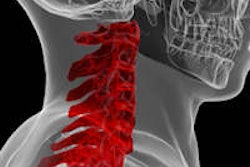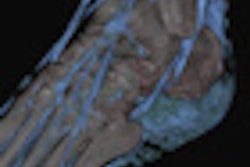Whole-body CT has excellent specificity but imperfect sensitivity for detecting spinal injuries in blunt trauma, concluded German researchers presenting at the 2012 American Academy of Spinal Surgeons (AAOS) meeting held earlier this month in San Francisco.
In their study of almost 1,000 patients presenting with blunt trauma and suspected spinal injury, 64-detector-row CT missed from 10% to 20% of the injuries, based on follow-up exams and other tests as a reference standard.
The prevalence of spine fractures in patients with major blunt trauma is high -- more than 34% in the German trauma registry, said Dr. Dirk Stengel, PhD, from the German Trauma Hospital in Berlin. Spine fractures are rarely immediately life-threatening, but they can lead to big problems if they remain undetected, and plain radiographs have limited utility in this setting.
"CT has emerged as the workhorse modality in the diagnosis of these patients -- it is widely regarded as a conclusive imaging tool," Stengel said. "The problem is, you are exposing the patient to radiation, and there is no proof of [CT's] efficacy or even impact on management decisions."
The study aimed to assess the diagnostic accuracy of whole-body 64-detector-row CT as a screening tool for detecting spine injuries in patients with blunt major trauma. The Pan-CT for Trauma Resuscitation Study (PATRES) was based on the trauma center's whole-body CT registry, and included patients who underwent contrast-enhanced whole-body CT over an 18-month period.
In 988 eligible patients (735 men, 253 women; mean age 42 ± 19 years), the study team recorded the presence of injuries to the upper, middle, and lower spine on initial scans. Two reviewers working independently correlated the findings to a detailed synopsis of follow-up data using hospital charts of clinical exams and subsequent CT and MRI studies.
"Of course, it's very difficult to compare the CT scan to a viable reference test, and for us the detailed synopsis of hospital charts and subsequent imaging [CT and MRI] were the best available reference test," Stengel said.
The researchers' analysis included a comparison of results between radiologists and clinicians' diagnostic tests for accuracy, sensitivity, and specificity. They performed stratification and sensitivity analyses with a group of nontrauma patients, taking another opportunity to help confirm the accuracy of the CT findings, Stengel said.
In the 988 patients, there were 361 (37%) multiple injuries, including roughly 100 cervical spine injuries, 122 thoracic spine injuries, and 116 lumbar spine injuries, "reflecting a typical European cohort" in which more than 60% of the major blunt trauma patients were involved in motor vehicle accidents, Stengel said. Patients' scans were acquired a median 29 minutes after hospital admission.
Interobserver agreement beyond chance was rated good to moderate (median κ = 0.03, interquartile range 0.39-0.71). CT's sensitivity for detecting injuries was 85.3% in the cervical spine, 80.6% in the thoracic spine, and 93.2% in the lumbar spine, and the results were similar in patients with multiple trauma. Importantly, longer follow-up periods or different verification tests had no consistent effect on CT's calculated accuracy. But taken as a whole, the accuracy results leave room for doubt, Stengel said.
"If your CT scan is positive and you have a pretest probability of a spinal injury of about 50% based on diagnostic tests, then you have a pretest probability of almost 99% that there is truly a spinal injury," he said. "The problem is that if you have a pretest probability of 50% and the scan is negative, it only reduces the post-test probability [of injury] by 20%, so there is still considerable uncertainty," he said.
In addition, the best balance between sensitivity and specificity is achieved by scanning about 30 minutes after admission, Stengel said. During the follow-up period, the incidence of relevant missed injuries was 1.4%.
Limitations of the study included its retrospective, single-center design and the use of an imperfect reference standard, Stengel said, adding that the research goes further than previous efforts in attempting to ascertain CT's true accuracy.
Spinal injuries detected at CT can be considered conclusive, according to Stengel; however, the modality's sensitivity is only moderate. Therefore, negative results need to be confirmed by clinical follow-up and additional imaging exams, he noted.
When a moderator asked what techniques might be used to reduce CT's false-negative rate, Stengel said some small steps can be useful, but only so much can be done.
"We usually admit these patients [for observation], though Germany is probably different from the U.S.," he said. "Maybe postponing the scan -- it needs some time for hematomas to develop and so on."
Finally, double reading of results can often turn up injuries that were missed the first time around, Stengel said.



















